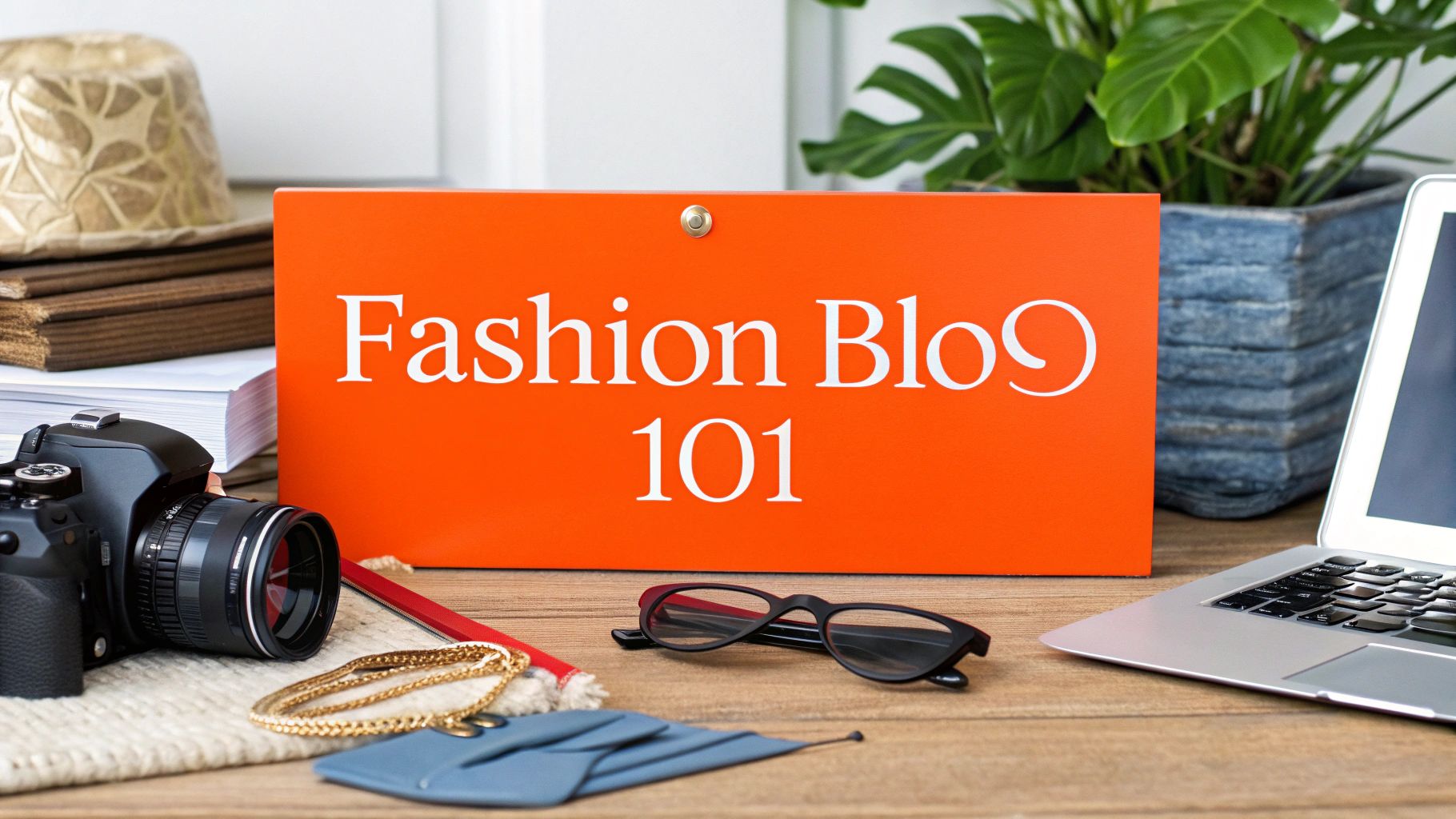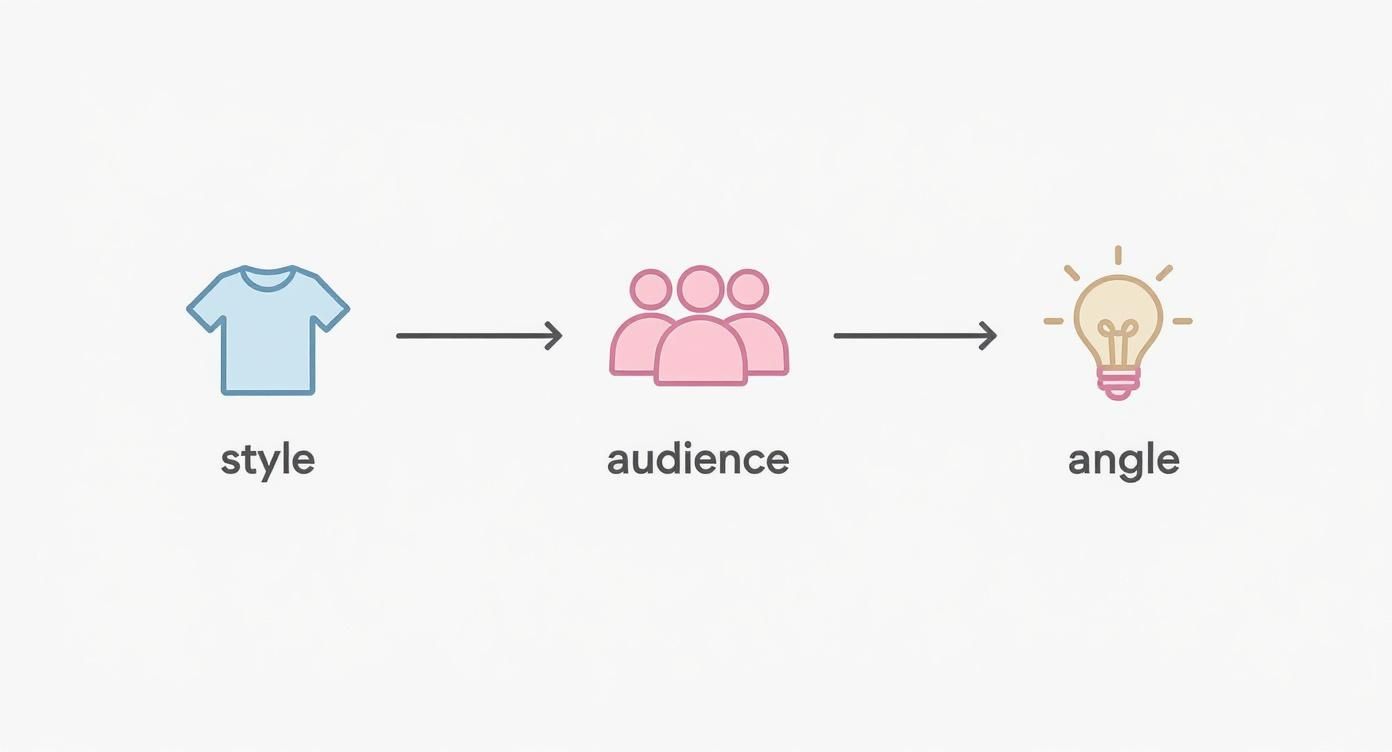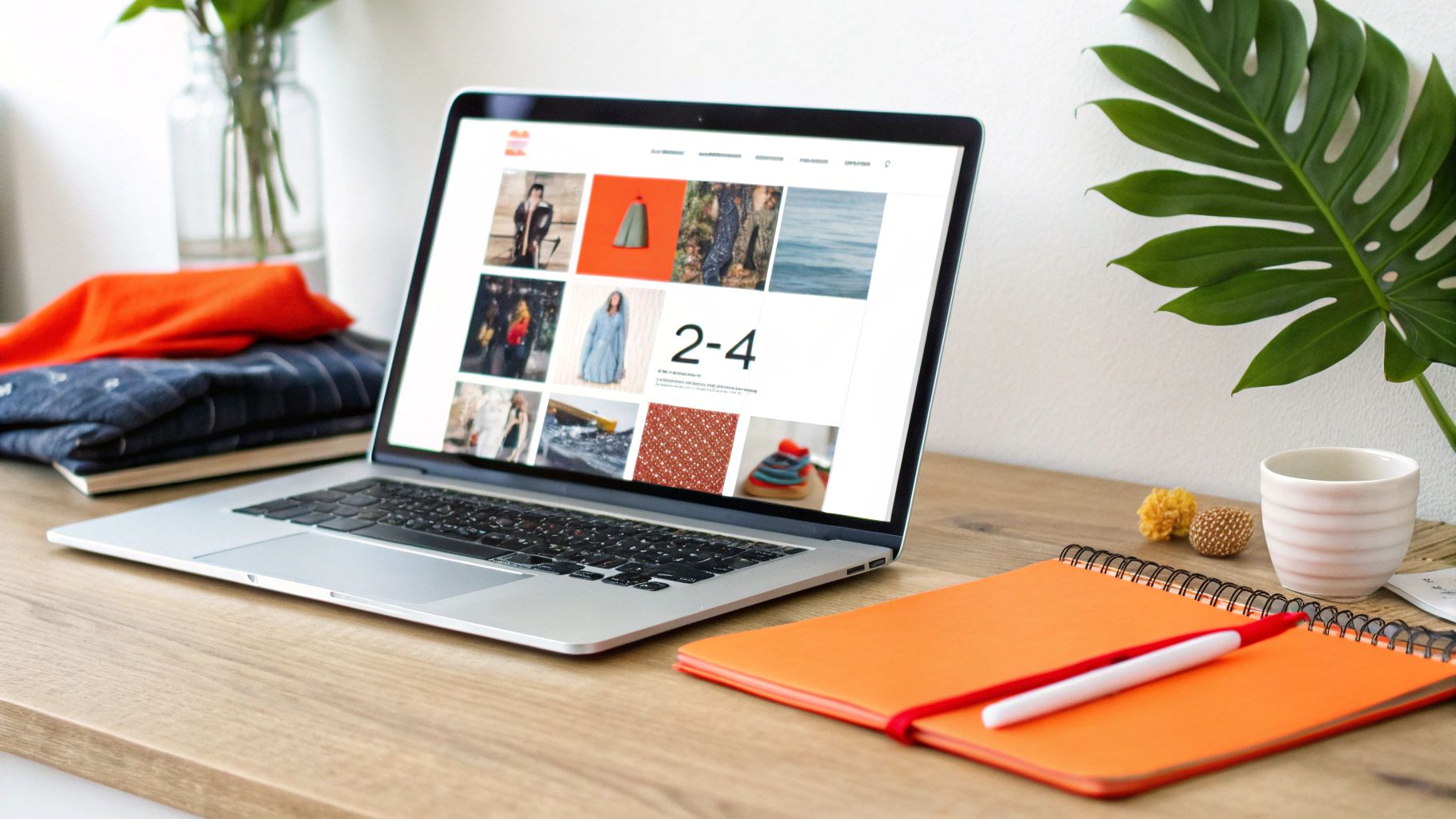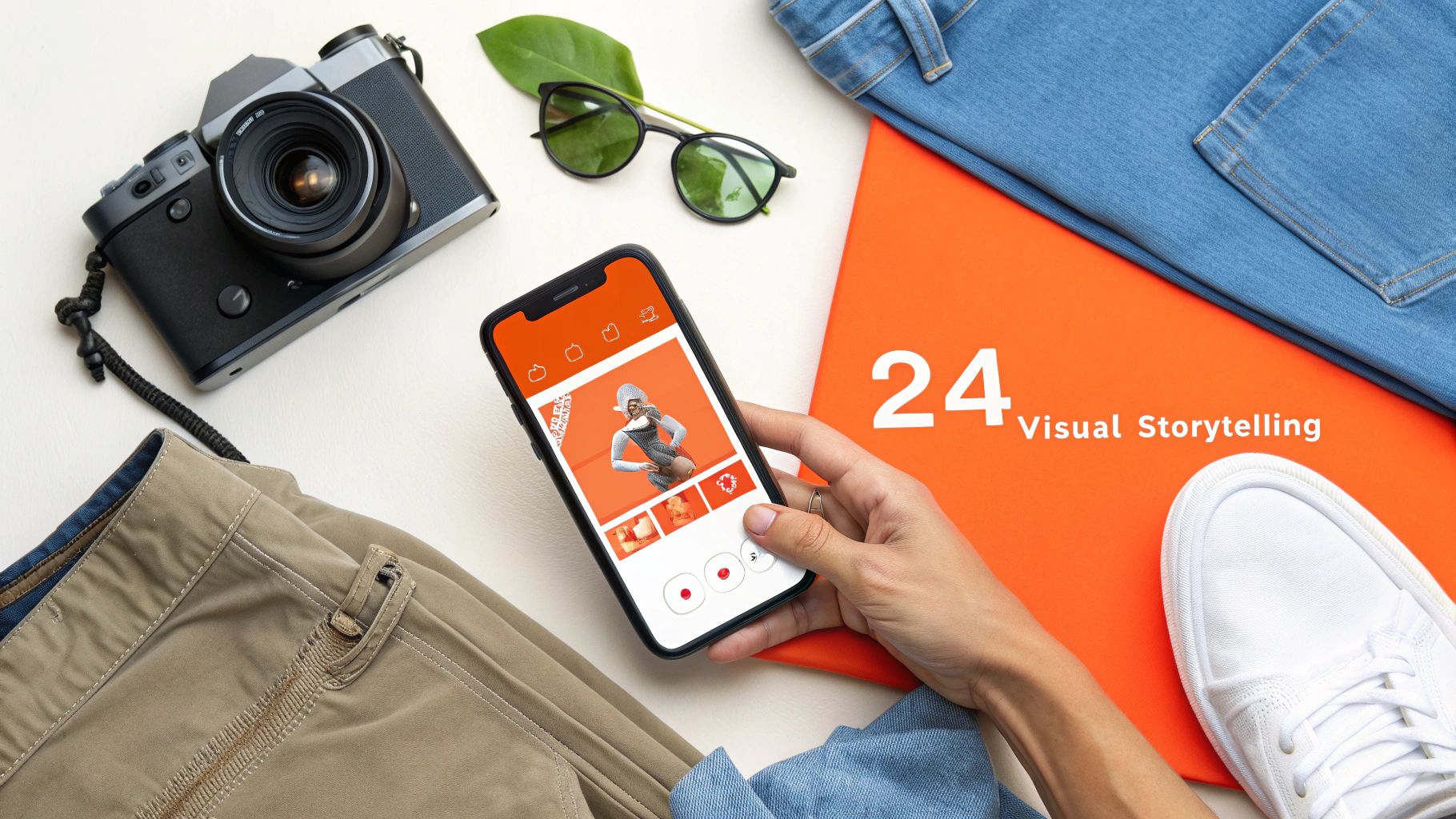
How do you start a fashion blog: A simple starter guide
Starting a fashion blog isn't just about snapping great photos. It's about finding your corner of the fashion world, setting up your digital home base, and creating content that genuinely connects with a specific group of people. The path is pretty clear: figure out your unique angle, build your blog, and start sharing your style with the world.
Finding Your Voice in a Crowded Style Scene
Before you even think about your first post, you need to lock down your niche. This is, without doubt, the most important decision you'll make. In an ocean of style content, being specific is your superpower. Broad, general fashion blogs are a dime a dozen and get lost in the noise. A blog with a razor-sharp focus, on the other hand, can start building a dedicated following from day one.
This means you have to go deeper. "Street style" is too broad. But what about "thrifted and upcycled streetwear for skaters"? Now we're talking. Instead of just "workwear," you could carve out a space with "bold, colorful corporate looks for creative professionals." This targeted approach immediately makes your content more valuable to the right people.
Identify Your Passion and Expertise
The best, most engaging content always comes from a place of genuine passion. What part of fashion gets you fired up? What do you find yourself talking about or researching for hours? Your perfect niche lies right where what you love meets what you know.
Let's get the wheels turning with some practical examples:
- Your Personal Style: Is your look really distinct? Actionable insight: If you always wear vintage 70s styles, your niche could be "Authentic 70s Vintage for the Modern Wardrobe," complete with guides on identifying genuine pieces and avoiding reproductions.
- A Specific Demographic: You could be the go-to resource for plus-size women in their 20s. Actionable insight: Create content like "The Top 5 Plus-Size Denim Brands That Don't Gap at the Waist" or "How to Style a Crop Top When You're a Size 18."
- A Budget Focus: A blog dedicated to finding amazing designer dupes. Actionable insight: A weekly series called "Luxe for Less" where you compare a $2,000 Bottega Veneta bag to a $90 alternative, showing side-by-side photos and material quality breakdowns.
- An Ethical Angle: Sustainable fashion is a powerful movement. Actionable insight: Don't just list brands. Review them. Create a post titled "I Tried 3 Sustainable T-Shirt Brands for a Month—Here's My Honest Review" to build trust and authority.
Find an Audience You Want to Serve
Who, exactly, are you talking to? It helps to picture a real person. Are you helping recent college grads build a professional wardrobe without breaking the bank? Or are you inspiring other busy parents to find practical yet stylish outfits? For instance, if you're targeting new moms, your content could be "5 Chic Diaper Bags That Look Like Designer Purses" or "The Ultimate Stain-Resistant Momiform: 3 Key Pieces." Knowing your audience inside and out will guide every single decision you make.
The secret is to solve a specific problem or provide unique inspiration for a well-defined group. When you try to be everything to everyone, you end up being nothing to no one. A sharp focus isn't limiting—it's magnetic.
Figuring out your unique angle is the first step toward building a successful blog. To help you brainstorm, let's look at how you can combine different fashion elements to create a standout niche. This matrix is designed to get you thinking about how a core style, a target audience, and a unique value proposition can come together.
Fashion Blog Niche Brainstorming Matrix
| Core Fashion Style | Target Audience | Unique Angle/Value | Example Niche |
|---|---|---|---|
| Minimalist | Young Professionals | Capsule wardrobes for work & travel | "The Corporate Minimalist" |
| Vintage/Retro | College Students | Thrifting hauls & upcycling tutorials | "Campus Retro Threads" |
| Sustainable/Ethical | Eco-conscious Consumers | Reviews of slow fashion brands | "Conscious Closet Collective" |
| Streetwear | Men over 30 | High-end sneakers & age-appropriate looks | "Grown-Up Sneakerhead" |
| Luxury Fashion | Budget-conscious Shoppers | Finding designer dupes & sale guides | "Affordable Luxury Finds" |
Use this table as a launchpad. Mix and match ideas, and don't be afraid to get incredibly specific. The more defined your niche is, the easier it will be to attract a loyal community that hangs on your every word.
The opportunity right now is huge. The global fashion market is projected to be worth around $1.84 trillion by 2025. This explosive growth creates so many pockets for new voices to emerge, from deep-dive runway analysis to practical guides on sustainable living. To really connect with modern shoppers, you'll want to focus on digital-first platforms like Instagram and TikTok. You can read more about the fashion industry's massive growth to see just how much potential is out there.
Building Your Blog's Digital Foundation
So, you've nailed down your niche. Fantastic. Now it's time to stake your claim on the internet and build the actual home for your fashion blog. This part can seem a little intimidating if you're not a "tech person," but it's really just two simple steps: picking an address and renting the space.
First up is your domain name. This is your blog’s address, like YourChicStyle.com. Actionable insight: Try using a domain name generator like Namecheap's "Beast Mode" to brainstorm ideas. If TheCorporateMinimalist.com is taken, try a variation like CorpMinimalist.com or TheMinimalistDesk.com. Stick with a .com if you can—it’s what people instinctively type and trust the most.
Next, you need web hosting. If your domain is the address, think of hosting as the piece of land you're building on. It’s where all your files—posts, photos, everything—will live, making sure your blog is online and available for everyone to see, day or night.
Choosing Your Platform and Host
When it comes to fashion blogging, there's really only one platform that serious creators use: WordPress.org. Don't get it mixed up with WordPress.com. The .org version is self-hosted, which is a fancy way of saying you have total freedom to design it, add features, and make money from it however you want. It's no wonder over 43% of all websites are built on it.
Your next decision is picking a hosting provider. My advice? Find a host that offers a "one-click" WordPress installation. It takes all the technical heavy lifting out of the equation.
Keep an eye out for providers that offer:
- A free domain name for the first year: This saves you about $15 upfront. Bluehost and Hostinger often have these deals.
- Reliable customer support you can actually reach: Look for 24/7 live chat support. You will need it.
- Good server performance to ensure your site loads fast: A slow site will kill your traffic. Check reviews for speed performance.
The infographic below really drives home how finding your niche—that sweet spot between your style, your audience, and your unique point of view—is the critical first step before you even think about domains and hosting.

As you can see, a powerful blog isn't just about one thing. It's about that perfect blend of what you love, who you're talking to, and what makes your voice stand out from the crowd.
Getting WordPress Installed
That "one-click install" feature I mentioned? It's a lifesaver. Once you sign up for hosting, you’ll get access to a control panel (usually called cPanel). Inside, you’ll find an icon for WordPress. Just click it, pick your new domain, create a username and password, and the system does the rest. It's that simple.
If you want to explore other user-friendly options, there are some great resources on the best website builders for beginners that can make this process even smoother.
Getting your domain, hosting, and WordPress set up is the foundational work. It's a one-time task that opens the door to all your creative possibilities. Do it right once, and you can focus on what really matters: creating incredible fashion content.
With the technical stuff handled, you now have a blank canvas waiting for your vision. You've cleared the biggest technical hurdle. Now for the really fun part: designing a blog that feels completely you.
Designing a Blog That Embodies Your Aesthetic
In the world of fashion, looks are everything. It’s no different for your blog. Think of your site's design as your digital storefront—it’s the very first impression you make. A clunky, generic, or poorly designed site can kill your credibility before a visitor even reads a single word.

The first real step in shaping your blog's look is picking a WordPress theme. This is the skeleton of your site, controlling the layout, fonts, and colors. It's the foundational piece that everything else is built upon.
Free vs. Premium Themes
It's tempting to just grab a free theme to get started, and honestly, some of them are pretty decent. But if you're serious about this, investing in a premium theme—which usually runs between $40 and $80—is one of the smartest moves you can make early on.
- Free Themes: These are great for dipping your toes in the water. The catch? You'll often run into limited customization options, fewer updates (which can be a security risk), and little to no support when things go wrong.
- Premium Themes: You really get what you pay for here. Premium themes typically come packed with design flexibility, dedicated customer support, and consistent updates to keep your site running smoothly and securely.
If you want a professional look without having to touch a line of code, I often recommend themes like Astra or Kadence. They are both incredibly lightweight (meaning they load fast) and highly customizable, which is perfect for image-heavy fashion blogs.
Creating Your Visual Brand Identity
Your brand isn't just your blog's name; it's the whole vibe. A consistent visual identity makes you look polished, professional, and far more memorable. And no, you don't need a design degree to pull it off.
Your Logo:
My advice? Keep it simple. A clean, text-based logo almost always looks more chic and high-end than a busy graphic. You can use a free tool like Canva to play around with fonts and whip up something that looks great in minutes. Actionable insight: A minimalist blog might use a crisp sans-serif font like Montserrat, while a blog focused on vintage finds could go for an elegant serif typeface like Playfair Display.
Your Color Palette:
Stick to two or three main colors that really capture the spirit of your niche. Actionable insight: Use a free tool like Coolors.co to generate a professional palette. For a sustainable fashion blog, that might mean earthy tones like olive green (#556B2F) and beige (#F5F5DC). For a streetwear blog, maybe it's a stark black (#000000) and white (#FFFFFF) with a jolt of neon yellow (#FFFF00). The key is to use these colors consistently everywhere.
Your blog’s design is a direct reflection of your personal style. It should feel like an extension of your wardrobe—curated, intentional, and uniquely you. A clean, navigable design builds trust and encourages visitors to stay and explore your content.
Don't forget that your photography is a massive part of your overall aesthetic. If you're looking for inspiration on how to capture stunning visuals, check out what the pros are doing. You can find some fantastic discussions and get great ideas from various subreddits for photographers. A powerful visual identity, from your theme right down to your images, is crucial when you're figuring out how do you start a fashion blog that truly stands out from the crowd.
Creating Content That Truly Connects
Alright, your blog is looking sharp. The design is in place, and it’s time to get to the heart of it all: the content. This is where you transform a pretty website into a destination people want to visit again and again. A truly successful blog isn't just a digital lookbook; it's a source of real value, inspiration, and personality. Your content strategy is what will build that loyal community.

The secret sauce for a great fashion blog is a smart mix of content. You need to think beyond simply posting your "outfit of the day." The real goal is to solve problems for your reader.
Here are a few content pillars that always work:
- Shopping Guides: Think like your reader. Posts like "The 5 Best White T-Shirts for Every Budget" or "Where to Find Vintage Denim That Actually Fits" are absolute gold. Actionable insight: Include a comparison table with columns for brand, price, material, and a "best for" category (e.g., "Best for Petites," "Best for Tall").
- Trend Breakdowns: See a new trend? Don't just show it—explain it. Actionable insight: Create a post titled "How to Wear the 'Coastal Grandmother' Trend Without Looking Frumpy" and show three complete, shoppable outfits at different price points.
- Personal Style Stories: This is how you build a genuine connection. Actionable insight: Instead of "What I Wore to a Wedding," try "What I Wore to My Best Friend's Wedding (And How I Hid a Red Wine Stain Mid-Reception)." It’s relatable, memorable, and human.
Mastering Visual Storytelling
Let's be real: in fashion, your visuals are everything. The photos have to be crisp, well-lit, and compelling. But don't panic—you don't need a $3,000 camera to get started. Your smartphone is an incredibly powerful tool if you know how to use it.
The biggest game-changer is natural light. Actionable insight: Shoot outdoors during the "golden hour"—that magical time right after sunrise or just before sunset. Use your phone’s portrait mode to get that blurry background (bokeh) effect that makes your subject pop. Also, learn the rule of thirds: enable the grid on your phone's camera and place your subject off-center for a more dynamic shot.
Editing is where you really define your brand's look. Free apps like VSCO or Adobe Lightroom Mobile are fantastic. The key here is consistency. Actionable insight: Find or create a preset you love, save it, and apply it to every photo. This creates a cohesive, professional, and instantly recognizable feed.
Simple On-Page SEO for Fashion Blogs
You can create the most beautiful, insightful content on the planet, but if no one can find it, it doesn’t do much good. This is where a little on-page SEO comes in, and it's not as scary as it sounds. It's just about helping search engines like Google understand what your posts are about.
Start by getting inside your reader's head. What would they actually type into Google? Actionable insight: Use a free tool like AnswerThePublic. Type in "fall outfit" and see what questions people ask. You might find "what to wear for apple picking" or "fall outfits for a first date." Instead of a vague title like "My Favorite Fall Look," title your post "A Cozy and Chic Fall Outfit for Apple Picking" to match their search exactly.
SEO isn't some dark art; it's simply about making your content as clear and helpful as possible for both humans and search engines. Use your main keyword in your title, the first paragraph, and a subheading to send strong signals about your topic.
This focus on discoverability is more important than ever. The global fashion e-commerce market is on track to blow past $1.25 trillion by 2024, and that growth is fueled by people searching online for inspiration. To get a piece of that pie, you have to be findable.
A great way to grow your audience and build authority is by writing for other publications. Look into opportunities for guest blogging for fashion; it can introduce your brand to a whole new set of readers and build valuable links back to your site.
Promoting Your Blog and Building a Community
Hitting "publish" on that first post feels amazing, but that’s just the start. Now comes the real work: getting your blog in front of people and turning those first-time readers into a loyal audience. This is what separates a personal journal from a truly influential fashion blog.

You have to show up where your potential readers are already spending their time. For fashion, that means visual platforms are non-negotiable. Think of Instagram, TikTok, and Pinterest as essential extensions of your blog—not just places to drop a link and hope for the best.
Mastering Visual Social Media
Each platform has its own vibe and purpose. You can't just spray the same content everywhere and expect it to work. You've got to play to each platform's strengths.
- Pinterest: This is a visual search engine. Actionable insight: For every blog post, create 3-5 different pin images in Canva using varied titles and photos. Use text overlays that solve a problem, like "5 Ways to Style a White Tee" or "The Ultimate Capsule Wardrobe Checklist." A pin that takes off can send consistent traffic to your blog for months.
- Instagram: This is where you build your brand. Actionable insight: Use your main feed for high-quality "hero" shots. Use Stories for the behind-the-scenes—ask questions using the poll sticker ("Which shoes should I wear?"), show unboxings, and share user-generated content to build community. Reels are perfect for quick styling hacks like "1 Skirt, 3 Ways."
- TikTok: It’s all about short, fun, trend-focused videos. Actionable insight: A blog post on a new seasonal trend can become a snappy 15-second video showing three different ways to wear it, set to a trending audio clip. It's low-effort, high-reward.
Just remember, promotion is a two-way street. It's not just about posting—it's about interacting. For a deeper dive, you can find a ton of proven social media engagement tips to help build a more active following.
Build Your Email List from Day One
Social media platforms can change their algorithms overnight, but your email list is something you will always own. It’s your direct line to your biggest fans. Seriously, start building one from the moment you launch.
Your email list is your inner circle. It's the group of people who have raised their hand and said, 'Yes, I want to hear more from you.' Treat that relationship with care, and it will become your blog's most powerful marketing tool.
Of course, you need to give people a good reason to sign up. A little freebie, often called a "lead magnet," works wonders. It doesn't need to be some epic e-book, either.
Simple Freebie Ideas:
- A Seasonal Capsule Wardrobe Checklist: A clean, one-page PDF with 15 essential pieces for a fall wardrobe.
- A Thrift Shopping Guide: Your top five personal tips for finding amazing secondhand treasures.
- A Style Quiz: Use a free tool like Interact to create a fun "What's Your Style Archetype?" quiz that emails the results.
Network with Peers and Brands
Finally, don't try to do this all alone. Blogging is a community, not a competition. Actionable insight: Make a list of 10-15 other bloggers in your niche who are at a similar stage. Make it a goal to leave a thoughtful, non-generic comment on one of their posts every week. This builds genuine relationships that can lead to collaborations, guest posts, and audience-sharing opportunities that help everyone grow.
Turning Your Passion Project into Profit
Once you’ve put in the work to build an engaged community, you're in a great spot to see a real return on your efforts. The key to monetizing a fashion blog isn't about flipping a single switch; it's about thoughtfully weaving in different income streams that feel true to your personal brand.
For most, the journey begins with affiliate marketing. This is simply earning a commission for recommending products you genuinely use and love. When someone clicks your special link and buys something, you get a small cut of the sale.
Actionable insight: Don't just drop links. Integrate them naturally. In a post about "The Best Jeans for Curvy Figures," include your personal review of three different pairs, with photos of you wearing them. Explain why you love the fit and fabric of each, and then include your affiliate links. This provides value first, making the sale feel organic. Platforms like LTK and ShopStyle Collective make it easy to create these links.
Landing Sponsored Collaborations
As your following expands, brands will inevitably start paying attention. Sponsored posts are a fantastic way to make money by teaming up with companies that fit your vibe. You’ll create content—maybe an Instagram post or a full blog article—showcasing a product, but always in your own voice and style.
To get these kinds of deals, you absolutely need a media kit. Think of it as your blog's professional resume. It should be a 1-2 page PDF that clearly presents:
- Your Mission: A quick bio about who you are and what your blog stands for.
- Audience Demographics: Who follows you? Include key stats like age, location, and gender (get this from your Google Analytics).
- Key Metrics: Show off your monthly blog visitors, social media numbers, and engagement rates (e.g., "Average Instagram Story views: 500").
- Past Collaborations: Include logos and links to previous brand work to showcase your quality.
Actionable insight: When you reach out to a brand, don't just say "I love your stuff." Be specific. Pitch an idea, like "I'd love to feature your new vegan leather jacket in a blog post titled '3 Ways to Style a Moto Jacket for Fall.' My audience of eco-conscious millennials would be a perfect fit."
Monetization works best when it enhances, not interrupts, the user experience. Your audience trusts your taste, so every paid partnership should feel like a natural extension of the content they already love.
Creating Your Own Products and Services
Looking beyond brand partnerships, what else can you offer your community directly? Many top-tier bloggers diversify their income by creating and selling their own products. This approach gives you total control and almost always results in higher profit margins.
Actionable insight: Start small with a digital product. If your readers constantly ask how you edit your photos, package your top 5 presets and sell them as a "Lightroom Preset Pack" for $25. Or, if your niche is capsule wardrobes, create a detailed "Seasonal Capsule Wardrobe E-book" for $15 that includes a checklist, styling guide, and shopping links.
To make this work, building an email list is non-negotiable. It provides a direct line to your most loyal followers to promote your own offerings. For a deeper dive, check out our guide on email marketing and lead generation. This is where you really start transforming that passion project into a sustainable business.
Got Questions About Starting a Fashion Blog?
Diving headfirst into the world of fashion blogging always brings up a few questions. It's totally normal. Let's tackle some of the most common ones I hear so you can get started with a clear head.
What’s the Real Startup Cost?
Believe it or not, you can get a polished, professional-looking blog up and running for less than $100.
Your main expenses are the domain name, which is usually about $15 for the year, and your web hosting. You can find solid introductory hosting plans for as low as $3 per month. You don't need a fancy, expensive theme right away—a good free one and the phone in your pocket are genuinely all you need to launch.
Do I Need a Pro-Level Camera?
Nope, not at all. The camera on your smartphone is more than powerful enough to get started. I've seen incredibly successful bloggers build their entire brand using just their iPhone.
Success comes down to how you use the tools you have, not how much they cost. Actionable insight: Your focus should be on finding great natural light, using your phone's gridlines to learn the basics of composition, and consistently using a free editing app like Lightroom Mobile to give your shots a professional, cohesive look.
How Long Does It Actually Take to Make Money?
This is the big one, isn't it? Building a blog that generates real income is a marathon, not a sprint. There's no magic switch.
You should plan on consistently creating high-quality, valuable content for at least 6 to 12 months before you can expect to see a steady income stream from things like affiliate marketing or brand partnerships. Actionable insight: Set realistic goals. Aim to make your first $100 from affiliate sales within 6 months. This is an achievable target that keeps you motivated as you build the audience required for larger brand deals.
Ready to turn your Reddit presence into a powerful growth engine? The team at Reddit Agency helps brands build authentic communities and drive measurable results. Learn more at https://redditagency.com.